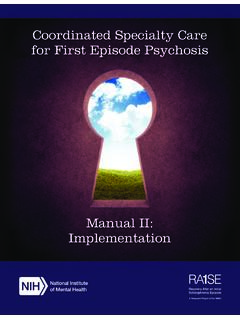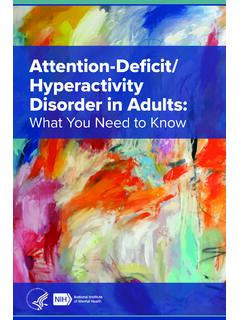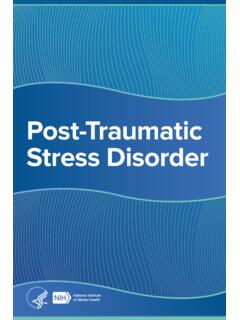Transcription of Evidence-Based Treatments for First Episode Psychosis ...
1 Evidence-Based Treatments for First Episode Psychosis : Components of Coordinated Specialty Care Robert K. Heinssen, , ABPP. Director, Division of Services and Intervention Research National Institute of Mental Health Room 7164, Mail Stop 9635. 6001 Executive Blvd. Bethesda, MD 20892-9635. Amy B. Goldstein, Associate Director of Prevention Research, and Chief, Child and Adolescent Preventive Intervention Program National Institute of Mental Health 301-496-7227; Susan T. Azrin, Chief, Primary Care Research Program NIMH Division of Services and Intervention Research 301-443-3267; April 14, 2014. 1. Background On January 17, 2014, President Barack Obama signed into law 3547, the Consolidated Appropriations Act, 2014. Recognizing that the majority of individuals with serious mental illness, such as schizophrenia, bipolar disorder, and major depression, experience the First signs of illness during adolescence or early adulthood, and that there are often long delays between symptom onset and the receipt of Evidence-Based interventions, the legislation provides funds to the Substance Abuse and Mental Health Services Administration (SAMHSA) to support the development of early Psychosis treatment programs across the United States.
2 A 5% set-aside (approximately $25M) has been allocated to SAMHSA's Mental Health Block Grant program to support the work. Senate Report 113-71, which accompanies the legislation, notes that multicomponent First Episode Psychosis (FEP) treatment programs already implemented in Australia, Canada, and the United Kingdom represent viable treatment models for improving symptoms, reducing relapse episodes, and preventing deterioration and disability among individuals suffering from psychotic illness. In order to ensure that programs with a demonstrated evidence base are established in the United States, the National Institute of Mental Health (NIMH) has been directed to assist SAMHSA in developing input for states regarding promising FEP treatment models.
3 In response to that directive, this document provides an overview of the Evidence-Based components of coordinated specialty care programs for the treatment of FEP. 2. First Episode Psychosis Approximately 100,000 adolescents and young adults in the United States experience FEP each year (calculated from McGrath, Saha, Chant, et al., 2008). With a peak onset occurring between 15-25. years of age, psychotic disorders such as schizophrenia can derail a young person's social, academic, and vocational development and initiate a trajectory of accumulating disability. Youth who are experiencing FEP are often frightened and confused, and struggle to understand what is happening to them. They also present unique challenges to family members and clinical providers, including irrational behavior, aggression against self or others, difficulties communicating and relating, and conflicts with authority figures.
4 Impaired awareness of illness may be an additional complicating factor. Despite these complexities, early intervention with Evidence-Based therapies offers real hope for clinical and functional recovery. Both meta-analytic and narrative reviews of randomized and quasi-experimental treatment studies conclude that early intervention services for Psychosis can improve symptoms and restore adaptive functioning in a manner superior to standard care (Bird et al., 2010; Penn et al., 2005). 3. evidence Supporting Early Intervention An abundance of data accumulated over the past two decades supports the value of early intervention following the First Episode of Psychosis . Clinical research conducted world-wide supports a variety of interventions for ameliorating psychotic symptoms and promoting functional recovery in FEP, including low doses of atypical antipsychotic medications (Robinson et al.)
5 , 2005; Sanger et al., 1999); cognitive and behavioral psychotherapy (Jackson et al., 2005; Lecomte et al., 2009; Lewis et al., 2005; Wang et al., 2003); family education and support (Goldstein et al., 1978; Leavey et al., 2004; Zhang et al., 1994); and (2). educational and vocational rehabilitation (Killackey et al., 2008; Nuechterlein et al., 2008; Nuechterlein et al., 2013). These Evidence-Based components often come together in specialized early intervention programs that emphasize prompt detection of Psychosis , acute care during or following periods of crisis, and recovery-oriented services offered over a 2-3 year period following Psychosis onset. Recent studies emphasize continuity of specialized care for up to five years post- Psychosis onset in order to consolidate gains achieved through initial treatment (Norman et al.
6 , 2011). Randomized controlled trials (Craig et al, 2004; Petersen et al., 2005), historical control investigations (Fowler et al., 2009; McGorry et al., 1996;. Mihalopoulos et al., 2009), and naturalistic effectiveness studies (Uzenoff et al., 2012) indicate that coordinated specialized services offered during or shortly after FEP are effective for improving clinical and functional outcomes among youth and young adults at risk for serious mental illness. In 2009, NIMH launched the Recovery After an Initial Schizophrenia Episode (RAISE) research initiative to explore methods for establishing coordinated specialty care programs for FEP in the United States. Two research investigations the RAISE Early treatment Program and the RAISE Connection Program were funded to develop, test, and implement coordinated specialty care programs in non-academic treatment settings.
7 Initial results from the RAISE projects suggest that mental health providers across multiple disciplines can learn the principles of coordinated specialty care for FEP, and apply these skills to engage and treat persons in the early stages of psychotic illness. These early findings, combined with the already reviewed evidence supporting early intervention in Psychosis , are so compelling that the question to ask is not whether early intervention works for FEP, but how specialty care programs can be implemented in community settings throughout the United States. 4. Coordinated Specialty Care Coordinated Specialty Care (CSC) is a team- based , multi-element approach to treating FEP that has been broadly implemented in Australia, the United Kingdom, Scandinavia, and Canada.
8 Component interventions include assertive case management, individual or group psychotherapy, supported employment and education services, family education and support, and low doses of select antipsychotic agents. In clinical trials, CSC has been restricted to persons with non-organic, non-affective psychotic disorders who have been ill for five years or less; empirical evidence regarding the effectiveness of CSC is greatest for persons who meet these criteria. CSC is intended primarily for youth, adolescents, and young adults ages 15-25, although some programs extend eligibility to age 30. Early intervention programs are designed to bridge existing services for these groups and eliminate gaps between child, adolescent, and adult mental health programs.
9 At its core, CSC is a collaborative, recovery-oriented approach involving clients, treatment team members, and when appropriate, relatives, as active participants. CSC emphasizes shared decision making as a means for addressing the unique needs, preferences, and recovery goals of individuals with FEP. Collaborative treatment planning in CSC is a respectful and effective means for establishing a positive therapeutic alliance and maintaining engagement with clients and their family members over time. CSC services are also highly coordinated with primary medical care, with a focus on optimizing a client's overall mental and physical health. (3). Team- based Approach In some regards, the CSC framework for FEP resembles the widely disseminated Assertive Community treatment (ACT) model of community- based psychiatric care.
10 Shared aspects include reliance on multi- disciplinary treatment teams, a small client to staff ratio, and a menu of services directed at supporting adaptive functioning in the community ( , case management, psychiatric treatment , housing and vocational assistance, substance abuse services, family education and support, and 24/7 accessibility). There are important differences between ACT and CSC models, however, including the clients served and the goals of treatment . In contrast to ACT, CSC teams serve a younger population without established disability, have the capacity for out-of-office visits but do not require them as the modal practice, and set expectations for a time-limited treatment experience of 2-3 years. If treatment is required beyond 3 years, most clients can step down to a lower level of specialized care, with eventual transition to regular services at the mental health center.
















